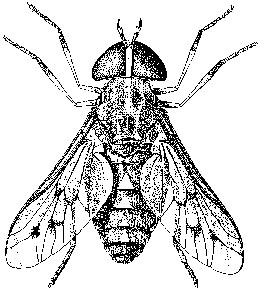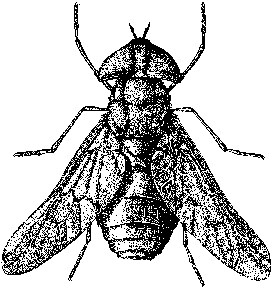Insecticide For Horse Flies
Horse flies (insect family Tabanidae) are probably the most severe fly pests of cattle on Missouri pasture and range (Figures 1 and 2). Only the females “bite,” but the blood-feeding activities of these large, agile insects can constitute a serious threat to economical cattle performance when populations are large.

T. equalis. Illustration by David G. Hall in Bulletin 256 of the Arkansas Agricultural Experiment Station (1930).

Tabanus atratus is one of the most easily recognized and notorious horse flies in eastern North America. This large, bluish-black fly with black wings can exceed 1 inch in length and inflict a very painful bite. The “blue-tailed fly” of early American ballad fame, this species readily attacks cattle, people and other hosts throughout Missouri during the summer. Illustration by David G. Hall in Bulletin 256 of the Arkansas Agricultural Experiment Station (1930).
Most Missouri horse flies have aquatic larval stages. The mother flies affix their eggs to vegetation near ponds and streams and the hatching larvae drop into the mud or water, where they live as predators for up to several years, depending on the species. When they are ready to pupate, they move from the water to terrestrial sites and generally emerge synchronously; that is, adults of a particular species all emerge at once, which facilitates mate-finding. Horse flies seem to be present all summer long. In fact, synchronous emergences result in one species being present for a time, then being replaced by another species, and so on. To cattle, however, it means being bitten the entire summer.
Female horse flies seek blood as raw material for energy and to manufacture eggs. The flies are evidently sensitive to parts of the electromagnetic spectrum that humans cannot see. Possibly their sight is like the “thermal vision” cameras used to detect heat leaks in houses. Horse flies are adept at locating warm-blooded animals; cattle, horses and similar large creatures are favored hosts. Humans are often bitten, especially around swimming pools, streams and ponds and on walks in the woods. The female fly uses her sharp mouthparts to slash a wound in the host’s skin and then laps up the blood that results. This produces pain and annoyance to the host, plus economically significant blood loss when horse fly populations are large and their feeding pressure is severe. Horse flies have been implicated in transmission of cattle anaplasmosis and other blood-borne diseases in livestock.
Because most horse flies are day-feeders, it is theoretically possible to protect Missouri cattle, horses and people from attack by staying inside during daylight hours. Because this is not practical for pastured beef cattle, producers need information on control techniques that will reduce horse fly biting rates on their livestock. Recommendations useful in other areas of the world, such as moving cattle from low-lying to high pasture in the summer, are ineffective in Missouri because the state’s geography is unsuitable.
(opens in new window)Insecticidal control
The biology of horse flies is such that they are not easily controlled by insecticides. Theoretically, it would be possible to kill the larvae by poisoning ponds and streams, but this is both illegal and logistically unworkable. Because the adult flies are large, robust insects that move quickly from host to host, it is difficult to apply enough insecticide to cattle to produce control without overdosing the cattle themselves. However, field trials have demonstrated that daily treatment of cattle with synergized pyrethrins (a natural insecticide extracted from plants of the genus Chrysanthemum) will reduce biting rates by horse flies without adversely affecting cattle. Generally, this has been feasible only for dairy cattle (and for horses) because of their high management level. Few producers are capable of, or willing to, round up beef herds every day, and even if this could be accomplished, the disruption of grazing might actually result in a greater economic loss than that caused by horse flies.
This economic equation changes, however, if the cattle can be made to treat themselves. Almost 50 years ago, MU entomologists Curtis Wingo and Stirling Kyd described an economical cattle self-spraying approach that produced effective horse fly control. It will still do so today.
(opens in new window)Insecticide to use
Obtain a concentrated pyrethrins insecticide labeled for direct application to beef or dairy cattle. For beef cattle, it should contain about 1 percent pyrethrins plus piperonyl butoxide (a synergist that improves the pyrethrins’ effect). Materials labeled for dairy cattle will contain less insecticide. Appropriate formulations are sold under various trade names by farm supply or agricultural chemical firms. If you plan to treat horses, be sure that you use a formulation labeled specifically for them.
(opens in new window)How to apply the spray
The insecticide must be sprayed on the cattle daily for best results, although partial control can be achieved by spraying it on every other day. If necessary, this can be done by hand. With horses or show cattle, it may be possible to rub or sponge the material on.
Use the insecticidal concentrate undiluted if so labeled, because a small amount of the undiluted material will give better protection than will larger amounts of spray diluted with water. On dairy cattle, the spray can be applied after the morning milking, by using a pump-up or atomizer hand sprayer. Direct the spray so that it wets the ends of the cow’s hair coat and do not apply so much spray that it wets the hide, or else blistering of the skin may occur. Only a few milliliters of spray per animal are required.
On beef cattle, the only practical method of applying a spray every day is to use an automatic treadle-type sprayer. This sprayer is installed in a chute constructed in a gate or similar opening that the cattle must pass through daily. On some farms, water tanks can be fenced to provide such a situation, or watering ponds may be used. In recent years, cattle sprayers using battery or solar power have been marketed, but these all incorporate mineral or similar bait and do not exploit forced-use placement.
Insecticide For Horse Flies
Horse flies are a common pest in the summer, and they can be a serious threat to your horses if they bite them.
The horse fly is a large insect that feeds on blood (hence the name). They don’t bite humans but they are aggressive toward other insects and animals.
Horse flies are not aggressive or dangerous to people or pets, but they can be annoying with their buzzing around you. They will bite if you bother them by swatting at them or otherwise provoking them. Horse flies have large eyes and are attracted to bright colors like blue and yellow. They also have good vision but cannot see well in bright light so you can use this to your advantage by wearing light clothing when working outdoors during daylight hours when these pests are most active.
If you have a problem with horse flies, there are insect repellents available for horses as well as sprays for humans such as DEET (N-diethyl-meta-toluamide), permethrin, picaridin and IR3535 .
List Of Insecticide For Horse Flies
- OUR STRONGEST FORMULA: Kills and repels 70+ species of flies, mosquitoes, ticks, and gnats
- WEATHERPROOF: Protection up to 17 days with UltraBond Technology
- NO MIXING: Ready to use, water-based formula for horses, ponies, dogs, barns, or on premise
- BUGS & SUN: Advanced formula contains protection against insects plus multiple sunscreens and coat conditioners
- USA: Made in the USA
Additional Info :
| Item Dimensions | |
| Height | 13.75 Inches |
| Width | 7.62 Inches |
| Length | 16.12 Inches |
| Weight | 8 Pounds |
- Citronella scented.
- Used by champions all over the country
- Also an excellent grooming aid
- Your Trusted Leader in Insect Control” for over 30 years
- Contains one of the highest concentrations of fly repellent available!
Additional Info :
| Item Dimensions | |
| Height | 9.5 Inches |
| Width | 2.75 Inches |
| Length | 2.75 Inches |
| Weight | 1.2 Pounds |
- OUR STRONGEST FORMULA: Kills and repels 70+ species of flies, mosquitoes, ticks, and gnats
- WEATHERPROOF: Protection up to 17 days with UltraBond Technology
- NO MIXING: Ready to use, water-based formula for horses, ponies, dogs, barns, or on premise
- BUGS & SUN: Advanced formula contains protection against insects plus multiple sunscreens and coat conditioners
- USA: Made in the USA
Additional Info :
| Item Dimensions | |
| Height | 10 Inches |
| Width | 4 Inches |
| Length | 4 Inches |
| Weight | 2.2 Pounds |
- USE ON HORSES & DOGS Repel-X Is an Excellent Horse Fly Spray and Tick Repellent
- REPELS & KILLS Six Common Fly Species, Mosquitoes, Gnats, Fleas and Ticks
- SPRAY Around Stalls or Barn to Repel Fly’s, Fleas, and Ticks
- GENTLY WIPE ON Horses and Dogs That Don’t Like to Be Sprayed
- READY-TO-USE Water Based Formula No Mixing or Diluting Required
Additional Info :
| Item Dimensions | |
| Height | 12.63 Inches |
| Width | 3.38 Inches |
| Length | 3.38 Inches |
| Weight | 2.105 Pounds |
- PROTECTS ANIMALS – This water-based formula protects horses, beef & dairy cattle, goats, sheep, swine, poultry & dogs. It can be sprayed directly on livestock when used as directed.
- BUG KILLER – Our product controls horn flies, face flies, house flies, horse flies, fruit flies, stable flies, & deer flies. It also controls species of mosquito, gnat, poultry lice, mite, flea, tick, cockroach, spider, cricket, ant, & more.
- INDOOR & OUTDOOR USE – Horse & Stable Fly Spray can be used indoors for spot applications only. Outdoor applications include lawn & soil treatment & around building foundations to prevent insect infestations.
- LONG-LASTING RESULTS – Horse & Stable Fly Spray’s fast-acting formula will keep working up to 4 weeks.
- READY TO USE – This product is conveniently ready to use when it arrives.
Additional Info :
| Color | Clear |
| Item Dimensions | |
| Height | 12 Inches |
| Width | 4.5 Inches |
| Length | 7.8 Inches |





